June, 2007 marks the month when the smartphone industry changed for good: focuses were shifted, last-minute decisions were made, prototypes were shelved and new ones were built, and all this because of one revolutionary device: the Apple iPhone.
Steve Jobs took to the stage at MacWorld 2007 on January 8 and, the charismatic presenter he was, announced to the world a device that was a phone, an iPod with touch controls, and an internet communicator, all three in one package. iPhone was officially launched on June 29 later that year and it, with its highly-successful successors, went on to break a number of records alongside being named Best Smartphone and Best Invention of the Year by a number of publications.

iPhone has come a long way since 2007, both in terms of hardware and software. Here’s a recap of that journey that has held fans mesmerized and the technology publications occupied.
iPhone: This is only the Beginning
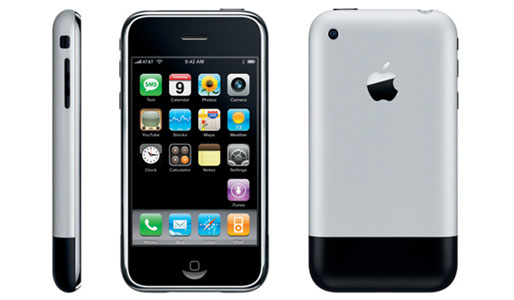
The first generation iPhone was introduced with a tagline of “Apple reinvents the phone”, and it surely lived up to the hype; 6.1 million sold units and several hundred meters long queues outside Apple’s and AT&T’s retail stores were a testament to that fact. iPhone was developed by Apple in collaboration with AT&T for an estimated cost of $150 million over a two-and-a-half year period.
iPhone featured a signature device design language that was both innovative and unique. An all-display front-panel—with the exception of the signature Home button—was something not many manufacturers had pulled off (RIP, LG KE850 Prada). The back featured a metal-covered panel with Apple’s logo and text. On the left, there was a dedicated mute key and volume rocker, while the top-right has the lock-button, a key configuration that hasn’t changed even 7 years into the future.
iPhone was powered by Samsung-made 412 MHz CPU, PowerVR MBX GPU, 128 MB of RAM, storage options of 4, 8 or 16 GB and a 1400 mAh battery. Its 3.5” display had a resolution of 320×480 pixels and the phone sported a 2 MP rear-facing camera without any LED flash. The phone also came equipped with proximity and ambient light sensors, alongside 3-axis accelerometer, pretty standard in today’s world but a hardware combination unheard of in those days.
The smartphone ran on iPhone OS 1.0. The innovative software enabled iPhone to respond to touch input accurately and better use the hardware resources for a smooth performance. Several software features that Apple highlighted during the announcement event were visual voicemail, Google Maps, advanced e-mail capabilities, cover-flow in music player, etc.
While the hardware specifications of the 1st gen. iPhone might sound terribly outdated by now, it was more of a combination of how everything worked on the phone that was important. Unlike almost every other manufacturer, Apple doesn’t boast of how many gigs of memory is under the hood, or what is the mAh specification of the iPhone’s battery. It relies on the experience that the device provides, which is more than satisfying for millions of buyers around the world.
iPhone was priced at a rather expensive sum of $499 for 4GB and $599 for 8GB models. The price was later dropped for 8GB to $399 and 4GB model was discontinued.
iPhone was finally discontinued in July 2008 and the last software update it received was iPhone OS 3.1.3.
iPhone 3G: The Mobile Apps Revolution
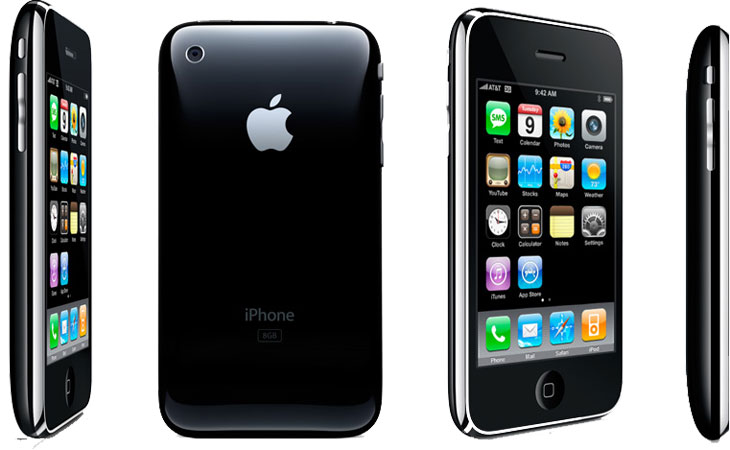 Most of the original iPhone’s criticism was directed at the lack of 3G compatibility and slow network speeds. Addressing these issues was apparently Apple’s foremost priority, which resulted in June 9 announcement of iPhone 3G at WWDC 2008.
Most of the original iPhone’s criticism was directed at the lack of 3G compatibility and slow network speeds. Addressing these issues was apparently Apple’s foremost priority, which resulted in June 9 announcement of iPhone 3G at WWDC 2008.
iPhone 3G used the same processing hardware and RAM as its predecessor. It came in 8 GB and 16 GB models with an 1150 mAh battery. The display was also the same 3.5” with 320×480 px. resolution. The 2 MP camera with geo-tagging support was also retained in this iteration.
The highlight feature of iPhone 3G was on the software side: iPhone OS 2.0, which allowed for several key enhancements like turn-by-turn navigation and push e-mail for instant notification, but perhaps the most important of these was the App Store. Apple had publicly released the iPhone OS SDK for third-party app developers to develop apps for iPhone on March 6, 2008, and by the launch time of iPhone 3G, there were some 500 apps in the App Store, a number that seems negligible when compared to today’s estimate of 1.2 million. Hence, it’s not unfair to say that the mobile apps revolution started with iPhone 3G.
iPhone 3G was discontinued in June 2010, and the final, major official software update it received from Apple was iOS 4.2.1
iPhone 3GS: Mending the Fundamentals
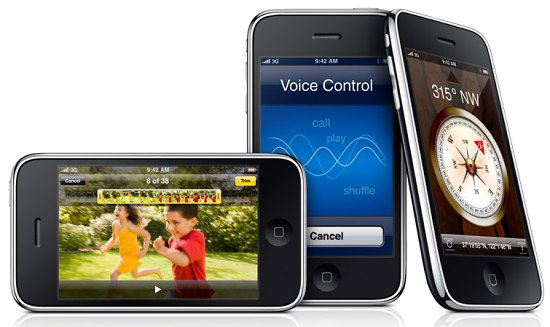 The third generation iPhone 3GS was announced during WWDC 2009 and went up for sale on June 19, 2009.
The third generation iPhone 3GS was announced during WWDC 2009 and went up for sale on June 19, 2009.
iPhone 3GS kept most of the design aesthetics of iPhone 3G but there were several under-the-hood enhancements. For the processor, iPhone 3GS used a Samsung SoC with 600 MHz ARM Cortex–A8 CPU, PowerVR SGX535 GPU and 256 MB of RAM. 32 GB storage option was introduced for the first time alongside standard 8 GB and 16 GB ones. The user-inaccessible battery was of 1220 mAh capacity. The display size and resolution did not change but the LCD was upgraded from 18-bit to 24-bit, which supported 16 million colors. Magnetometer and built-in compass were two new features as well.
The camera department also saw a number of improvements. The sensor resolution was upgraded from 2 to 3.15 megapixels and the ability to record videos was added for the first time. The software also supported geo-tagging and touch-to-focus capabilities for both video and still images.
iPhone 3GS debuted with iPhone OS 3.0. The software allowed for a number of improvements and features like Voice Control, which lets the users dictate commands to the phone by long-pressing the Home button. Other software features included VoiceOver, Color inversion, long-awaited Copy and Paste, MMS, and Text Zoom.
The iPhone 3GS was discontinued in September 2012, but supported iOS until iOS 6.1.6.
iPhone 4: An Overhaul is in the Order
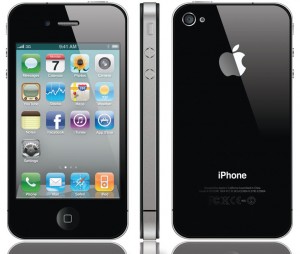
Fourth-generation iPhone 4 was the first smartphone offering from Apple to see a major design overhaul since the original iPhone. It featured a stainless steel frame which also worked as an antenna with scratch-resistant glass on both front and back. Major design changes constituted a front-camera besides the earpiece and the SIM card slot was moved from the top to the phone’s right side. At 9.3mm, iPhone 4 was introduced as the world’s thinnest smartphone of its time.
iPhone 4’s new antenna design, highlighted in particular by Steve Jobs during the June 7 announcement at WWDC 2010, was marked by controversies as it was reported that the phone lost cellular signals when held in a certain way, a claim to which Steve Jobs’ reply became notoriously popular: “Just avoid holding it that way.”
There were significant hardware changes beneath the covers as well. iPhone 4 used Apple A4 SoC with ARM Cortex-A8 CPU and PowerVR SGX 535 GPU. RAM capacity was doubled to 512 MB, and storage options remained the same: 8, 16 and 32 GB. A 1420 mAh battery powered the package. Dual microphones for noise-cancellation and a 3-axis gyroscope were introduced in iPhone 4.
There were some note-worthy upgrades in display and camera departments as well. The term ‘Retina Display’ was first heard at the announcement of iPhone 4, which showcased a high-resolution, 960×640 pixel, 3.5” display (~326 ppi). For the camera, the sensor resolution was pumped up to 5 MP, and it was coupled by an LED flash for the first time, and 5x digital zoom. Also included was a front-facing VGA camera for video-chat and (not-so-perfect) selfies.
iPhone 4 was released with iOS 4 on-board. iOS 4 introduced a new multitasking feature that allowed for switching from apps by letting the apps enter a suspended state until they are invoked again. FaceTime feature used the device’s front-facing camera for video calls. Other software additions included the ability to set background for Homescreen, internet tethering, apps and photos categorization, better notes and contacts synchronization, among others.
iPhone 4 officially ran its course in September 2013; it was the oldest iPhone device to receive iOS 7 update from Apple, with the last release being iOS 7.1.1.
iPhone 4S: The Reign of Virtual Assistants Begins
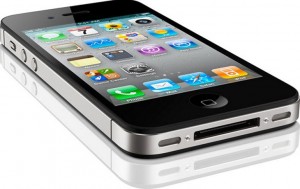 Apple sought to rectify the glitches in the antenna design of its previous iPhone models alongside adding some new features in the iPhone 4S, which was announced on October 4, 2011, a day before Steve Jobs’ death.
Apple sought to rectify the glitches in the antenna design of its previous iPhone models alongside adding some new features in the iPhone 4S, which was announced on October 4, 2011, a day before Steve Jobs’ death.
iPhone 4S incorporated Apple A5 chipset with a dual-core ARM Cortex A9 CPU clocked at 800 MHz, PowerVR SGX 543-MP2 GPU and 512 MB of RAM. It was the first iPhone model to be introduced with a 64 GB options of internal storage besides the standard 16 and 32 GB offerings (an 8 GB model was offered later in 2013).
Apple used a Sony-manufactured 8 MP rear camera in the device with a BSI sensor, facial detection and image stabilization. The camera was also capable of panorama shots and recording 1080p videos.
iOS 5.0 was available with iPhone 4S, and it introduced a plethora of new features, the most important and significant one of them being the voice-controlled automated service ‘Siri’. Siri is the natural-language artificially-intelligent personal assistant that can be activated by long-pressing Home button. Users can then ask Siri questions or give commands in supported languages which are answered using the Internet search or phone’s on-board software accordingly. Siri was highly praised on iPhone 4S’ release, overshadowing almost all other software features of iOS 5, some of which included iCloud, iMessage, wireless synchronization of iTunes with the device, some deeply-integrated social media and device services etc.
iPhone 4S was released on October 14th, and Apple has sold 4 million units in three days of launch. The device was discontinued in 2013, and last official update for iPhone 4S was iOS 7.1.1. The device is also eligible for iOS 8 update.
iPhone 5: Real-Estate Matters
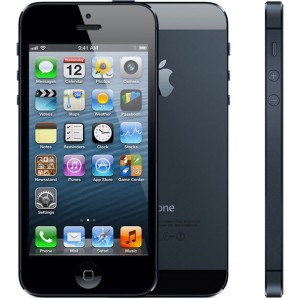
The sixth-generation, iPhone 5 was introduced at a special event on September 12, 2012, and launched a week later on September 21.
iPhone 5 was the first iPhone model to sport a larger display since the original iPhone in 2007. The display-size upgrade on iPhone 5 from 3.5” to 4” saw only a vertical increment, with width remaining the same, which meant a change of display’s aspect ratio and resolution to 16:9 (vs the original 3:2) and 1136×640 as well, respectively. Another significant hardware change was the replacement of classic 30-pin connector with a new 8-pin Lightning dock connector. 3.5mm headphone jack was also moved from top to the bottom of the device. The design also saw an upgrade as 4S’ glass body was replaced by an overall brushed aluminum frame.
Major specifications of iPhone 5 included Apple A6 SoC with ARM v7-based dual-core 1.3 GHz Swift CPU, PowerVR SGX 543-MP3 GPU, 1 GB of RAM and 16, 32 and 64 GB internal memory options. The phone featured a Sony-made sensor for rear camera with 5-element lens and f/2.4 aperture. Front camera was upgraded to 1.2 MP for iPhone 5.
Apple introduced its own Maps application with iPhone 5’s iOS 6, and removed Google Maps which was the default maps application prior to the change. Apple Maps generated a lot of controversy for extremely inaccurate results and lack of information. Social websites integration was strengthened with iOS 6, while the ability to collect entrance/boarding passes and tickets was added via Passbook application. Siri was also improved to answer a broader range of questions.
General public response to the phone’s launch was fervent, while critics’ reviews were mostly favorable. iPhone 5 was discontinued only a year later, a decision that was made to favor the sales of low-cost iPhone 5C model introduced that year.
iPhone 5C and iPhone 5S: Going Colorful, and Premium
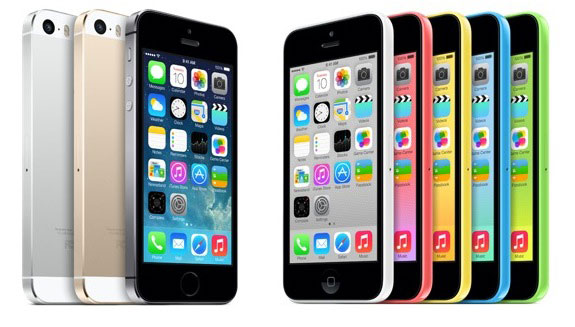
Withdrawing from its tradition, Apple announced two devices from the same category for the first time on September 12, 2013: iPhone 5S and the iPhone 5C.
iPhone 5S is a standard upgrade for last year’s iPhone 5, and iPhone 5C is a midrange counterpart for the series. Several major features were announced for the new iPhone line-up. iPhone 5S incorporated a 64-bit SoC, a first in smartphone industry, with an M7 motion-sensing co-processor. CPU on iPhone 5S is dual-core 1.3 GHz Cyclone, with PowerVR G6430 GPU and 1GB of RAM. Storage options for 5S are 16, 32 or 64 GB.
iPhone 5S also introduced Touch ID, a fingerprint scanner built into the Home button for unlocking device and authenticating iTunes purchases. Another major improvement was the camera, which featured f/2.2 aperture, slow-motion video recording, and dual-tone LED slash (warm and cool), and a 2.2 MP front-facing camera.
iPhone 5C has essentially the same hardware as iPhone 5 except the storage options where it shuns 64 GB for a more range-specific 8 GB one. Where it does differ is the design. iPhone 5C incorporates a colorful polycarbonate body with several color choices.
iPhone 5S and 5C debuted with iOS 7, the latest version of iOS currently available for public. iOS 7, in a remarkable shift from Apple’s signature skeuomorphic design, introduced a ‘flat’ look-and-feel with thin and clean typography, and colorful palette- and gradient-based imagery, icons and typefaces. Also introduced with iOS 7 was AirDrop for creating an ad-hoc, shared Wi-Fi platform, Hotspot tethering, new Control Center which accumulated basic settings and toggles in one panel, iTunes Radio, male and female voices for Siri, etc.
iPhone 5C is generally believed to have failed at generating enough market demand and revenue because of 5S outselling it in almost every market except a couple, while 5S was considered a success. 5S was received positively but some critics and industry professionals commented about the security of Touch ID, and the need for a 64-bit processor at this point.
Conclusion
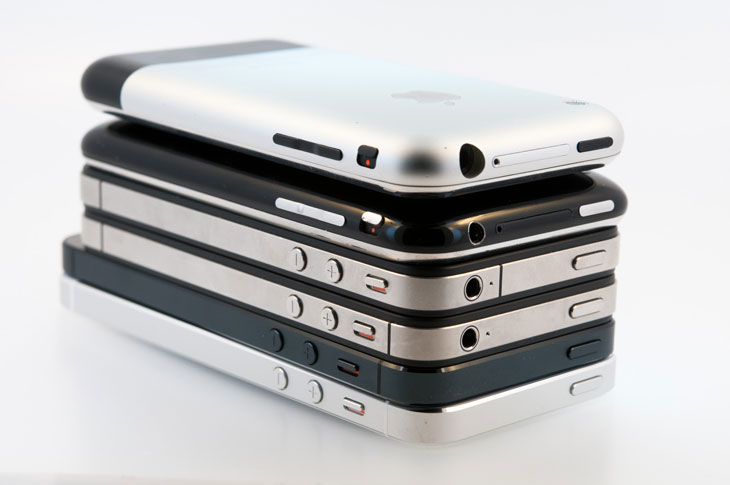
Overtime, Apple has been accused by some of infringing and copying the features from its rivals, and of having become stagnant and void of innovation by others. While there might be some truth in these claims, what no one can refute is that no products create as much hype as Apple’s, and especially the iPhones for the most part. Apple has sold 500 million iPhone devices till date, a number that most of its rivals cannot even hope to match in high-end category.
All this points to only one thing: Apple is still strong, and there is a long way to go before the popularity of its brands even start to see a decline.
–Images courtesy: iMore, GSMArena, AnandTech, BandwidthBlog, MacRumors, PhoneArena, 3G.co.uk










